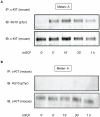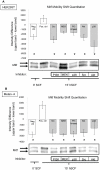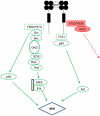C-KIT signaling depends on microphthalmia-associated transcription factor for effects on cell proliferation
- PMID: 21887372
- PMCID: PMC3161112
- DOI: 10.1371/journal.pone.0024064
C-KIT signaling depends on microphthalmia-associated transcription factor for effects on cell proliferation
Abstract
The development of melanocytes is regulated by the tyrosine kinase receptor c-KIT and the basic-helix-loop-helix-leucine zipper transcription factor Mitf. These essential melanocyte survival regulators are also well known oncogenic factors in malignant melanoma. Despite their importance, not much is known about the regulatory mechanisms and signaling pathways involved. In this study, we therefore sought to identify the signaling pathways and mechanisms involved in c-KIT mediated regulation of Mitf. We report that c-KIT stimulation leads to the activation of Mitf specifically through the c-KIT phosphorylation sites Y721 (PI3 kinase binding site), Y568 and Y570 (Src binding site). Our study not only confirms the involvement of Ras-Erk signaling pathway in the activation of Mitf, but also establishes that Src kinase binding to Y568 and Y570 of c-KIT is required. Using specific inhibitors we observe and verify that c-KIT induced activation of Mitf is dependent on PI3-, Akt-, Src-, p38- or Mek kinases. Moreover, the proliferative effect of c-KIT is dependent on Mitf in HEK293T cells. In contrast, c-KIT Y568F and Y721F mutants are less effective in driving cell proliferation, compared to wild type c-KIT. Our results reveal novel mechanisms by which c-KIT signaling regulates Mitf, with implications for understanding both melanocyte development and melanoma.
Conflict of interest statement
Figures







Similar articles
-
Signaling and transcriptional regulation in the neural crest-derived melanocyte lineage: interactions between KIT and MITF.Development. 2000 Dec;127(24):5379-89. doi: 10.1242/dev.127.24.5379. Development. 2000. PMID: 11076759
-
A single UVB exposure increases the expression of functional KIT in human melanocytes by up-regulating MITF expression through the phosphorylation of p38/CREB.Arch Dermatol Res. 2010 May;302(4):283-94. doi: 10.1007/s00403-009-1007-x. Epub 2009 Nov 24. Arch Dermatol Res. 2010. PMID: 19937254
-
The stem cell factor-stimulated melanogenesis in human melanocytes can be abrogated by interrupting the phosphorylation of MSK1: evidence for involvement of the p38/MSK1/CREB/MITF axis.Arch Dermatol Res. 2018 Apr;310(3):187-196. doi: 10.1007/s00403-018-1816-x. Epub 2018 Jan 23. Arch Dermatol Res. 2018. PMID: 29362867
-
Signaling Cascades Activated by UVB in Human Melanocytes Lead to the Increased Expression of Melanocyte Receptors, Endothelin B Receptor and c-KIT.Photochem Photobiol. 2018 May;94(3):421-431. doi: 10.1111/php.12848. Epub 2018 Mar 8. Photochem Photobiol. 2018. PMID: 28977677 Review.
-
[The Importance of MITF Signaling Pathway in the Regulation of Proliferation and Invasiveness of Malignant Melanoma].Klin Onkol. 2016 Fall;29(5):347-350. doi: 10.14735/amko2016347. Klin Onkol. 2016. PMID: 27739313 Review. Czech.
Cited by
-
Feeder-free Derivation of Melanocytes from Human Pluripotent Stem Cells.J Vis Exp. 2016 Mar 3;(109):e53806. doi: 10.3791/53806. J Vis Exp. 2016. PMID: 26967464 Free PMC article.
-
A 9‑gene expression signature to predict stage development in resectable stomach adenocarcinoma.BMC Gastroenterol. 2022 Oct 14;22(1):435. doi: 10.1186/s12876-022-02510-8. BMC Gastroenterol. 2022. PMID: 36241983 Free PMC article.
-
Plants as Modulators of Melanogenesis: Role of Extracts, Pure Compounds and Patented Compositions in Therapy of Pigmentation Disorders.Int J Mol Sci. 2022 Nov 26;23(23):14787. doi: 10.3390/ijms232314787. Int J Mol Sci. 2022. PMID: 36499134 Free PMC article. Review.
-
A new 12-gene diagnostic biomarker signature of melanoma revealed by integrated microarray analysis.PeerJ. 2013 Mar 5;1:e49. doi: 10.7717/peerj.49. Print 2013. PeerJ. 2013. PMID: 23638386 Free PMC article.
-
Three Novel KIT Polymorphisms Found in Horses with White Coat Color Phenotypes.Animals (Basel). 2025 Mar 22;15(7):915. doi: 10.3390/ani15070915. Animals (Basel). 2025. PMID: 40218308 Free PMC article.
References
-
- Kasamatsu S, Hachiya A, Higuchi K, Ohuchi A, Kitahara T, et al. Production of the soluble form of KIT, s-KIT, abolishes stem cell factor-induced melanogenesis in human melanocytes. J Invest Dermatol. 2008;128:1763–1772. - PubMed
-
- Wehrle-Haller B. The Role of Kit-Ligand in Melanocyte Development and Epidermal Homeostasis. Pigment Cell Res. 2003;16:287–296. - PubMed
-
- Vincent S, Segretain D, Nishikawa S, Nishikawa SI, Sage J, et al. Stage-specific expression of the Kit receptor and its ligand (KL) during male gametogenesis in the mouse:a Kit-KL interaction critical for meiosis. Development. 1998;125:4585–4593. - PubMed
Publication types
MeSH terms
Substances
Grants and funding
LinkOut - more resources
Full Text Sources
Molecular Biology Databases
Miscellaneous

